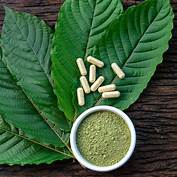Kratom (Mitragyna speciosa) belongs to the coffee family. It’s found in Southeast Asia and Africa. Traditionally, people have:
- Chewed kratom leaves.
- Made kratom tea to fight tiredness and improve productivity.
- Used kratom as medicine.
- Substituted kratom for opium.
- Used kratom during religious ceremonies.
Low doses of kratom can make you more alert, and higher doses can cause:
- Decreased pain.
- Pleasure.
- Sedation.
The mechanism of action seems to be that two of the compounds in kratom (mitragynine and 7-hydroxymitragynine) interact with opioid receptors in your brain.
Kratom is thus being promoted as a pain remedy that is safer than traditional opioids, an effective addiction withdrawal aid, and a pleasurable recreational tonic. But kratom is, in fact, a dangerous and unregulated drug that can be purchased on the Internet, a habit-forming substance that authorities say can result in opioid-like abuse and death.
The Food and Drug Administration (FDA) warned that kratom possesses the properties of an opioid, thus escalating the government’s effort to slow the usage of this alternative pain reliever. The FDA stated that the number of deaths associated with kratom use has increased. Now further concerns have emerged.
This review enumerates seven outbreaks of kratom (Mitragyna speciosa) product adulteration and contamination in the context of the United States Dietary Supplement Health and Education Act (DSHEA).
At least seven distinct episodes of kratom product contamination or adulteration are known:
- (1) krypton, a kratom product adulterated with O-desmethyltramadol that resulted in at least nine fatal poisonings;
- (2) a suspected case of kratom contamination with hydrocodone and morphine;
- (3) a case of kratom adulteration with phenylethylamine;
- (4) contamination of multiple kratom products with heavy metals;
- (5) contamination of kratom products by multiple Salmonella enterica serotypes;
- (6) exposure of federal agents raiding a synthetic cannabinoid laboratory to kratom alkaloids;
- (7) suspected kratom product adulteration with exogenous 7-hydroxymitragynine.
The authors concluded that inadequate supplement regulation contributed to multiple examples of kratom contamination and adulteration, illustrating the potential for future such episodes involving kratom and other herbal supplements.

I’m glad that you pointed out that the trouble lies with adulterated kratom products. Pure kratom is safe.
@Rose Ha
No, the issues to do with adulteration are described as “further concerns”.
Here are some recent reviews:
https://pubmed.ncbi.nlm.nih.gov/31099038/
https://pubmed.ncbi.nlm.nih.gov/31994019/
https://pubmed.ncbi.nlm.nih.gov/31999896/